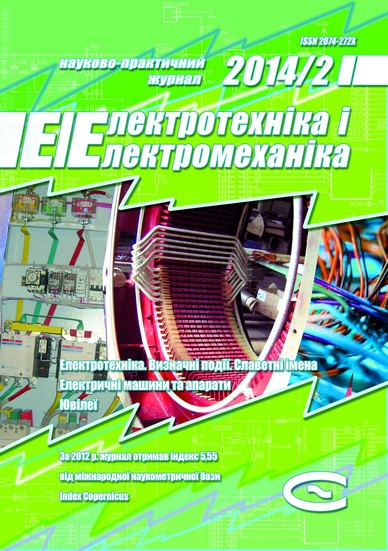STUDY OF FREQUENCY-CONTROLLED ASYNCHRONOUS MOTOR UNITS TEMPERATURE VERSUS LOAD AND POWER SUPPLY TYPE
DOI:
https://doi.org/10.20998/2074-272X.2014.2.04Keywords:
inverter, frequency-controlled asynchronous motor, losses, loads, high harmonics, temperatureAbstract
An equivalent thermal circuit is developed to form the basis of a system of heat-balance equations for a frequency-controlled induction motor. With the system of equations, temperatures of АИР 90В2 induction motor stator and rotor windings and cores are calculated and experimentally confirmed. The load dependence of the machine most heated units temperature at different forms of the supply voltage is revealed.
References
Bolgarskiy A.V., Muhachev G.A., Shchukin V.K. Termodinamika i teploperedacha. Moscow, Vysshaya shkola Publ., 1975. 495 p.
Petrushin V.S. Jenergeticheskie i teplovye pokazateli reguliruemyh asinhronnyh dvigatelej s uchetom vysshih prostranstvenno-vremennyh garmonik. Elektromashynobuduvannya ta elektroobladnannya, 2008, no.70, pp. 68-71.
Borisenko A.I., Dan'ko V.G., Yakovlev A.I. Aerodinamika i teploperedacha v elektricheskih mashinah. Moscow, Energiya Publ., 1974. 560 p.
Petrenko A.N., Tanyanskyi V.V., Petrenko N.Ya. Temperaturnoe pole i teplovye potoki chastotno-upravljaemogo asinhronnogo dvigatelja. Bulletin of NTU "KhPІ", 2012, no.49, pp. 61-65.
Downloads
Published
How to Cite
Issue
Section
License
Copyright (c) 2015 T. V. Vakaruk, N. Ya. Petrenko, A. N. Petrenko

This work is licensed under a Creative Commons Attribution-NonCommercial 4.0 International License.
Authors who publish with this journal agree to the following terms:
1. Authors retain copyright and grant the journal right of first publication with the work simultaneously licensed under a Creative Commons Attribution License that allows others to share the work with an acknowledgement of the work's authorship and initial publication in this journal.
2. Authors are able to enter into separate, additional contractual arrangements for the non-exclusive distribution of the journal's published version of the work (e.g., post it to an institutional repository or publish it in a book), with an acknowledgement of its initial publication in this journal.
3. Authors are permitted and encouraged to post their work online (e.g., in institutional repositories or on their website) prior to and during the submission process, as it can lead to productive exchanges, as well as earlier and greater citation of published work.





